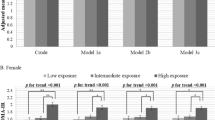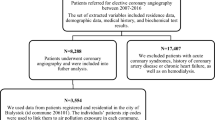Abstract
Objectives
This study aimed to evaluate the associations between ambient air pollutants, obesity, and kidney function.
Subjects/methods
We enrolled 3345 people who had undergone health checkups at Seoul National University Hospital. We recorded the annual average concentrations of ambient air pollutants, including particulate matter with an aerodynamic diameter of ≤10 μm (PM10), nitrogen dioxide (NO2), sulfur dioxide (SO2), and carbon monoxide (CO), in each subject’s residential area. Various obesity traits, such as body mass index, waist circumference, and visceral and subcutaneous adipose tissue areas, were measured by quantified computerized tomography (CT), and kidney function was assessed in relation to estimated glomerular filtration rate as an indicator of kidney function.
Results
High PM10, NO2, SO2, and CO concentrations were significantly associated with decreased kidney function (β = −2.39 and standard error = 0.32, −1.00 and 0.31, −1.23 and 0.28, and −1.32 and 0.29, respectively), and with the prevalence of chronic kidney disease (CKD). The association between air pollutant concentrations and decreased kidney function, including CKD, was stronger among those with high abdominal adiposity, as defined by CT measurement. For example, the association between increased concentrations of air pollutants and the prevalence of CKD was stronger in the group with greater visceral adiposity than in the group with less visceral adiposity (aORs = 1.29 vs 1.16 for PM10, 1.42 vs 1.21 for SO2, and 1.27 vs 1.11 for CO).
Conclusions
Long-term exposure to higher concentrations of air pollutants was unfavorably associated with kidney function and CKD prevalence, especially in people with abdominal obesity. This may indicate a high susceptibility to air pollutants in obese people.
This is a preview of subscription content, access via your institution
Access options
Subscribe to this journal
Receive 12 print issues and online access
$259.00 per year
only $21.58 per issue
Buy this article
- Purchase on Springer Link
- Instant access to full article PDF
Prices may be subject to local taxes which are calculated during checkout
Similar content being viewed by others
References
World Health Organization. Ambient air pollution: a global assessment of exposure and burden of disease. Geneva: World Health Organization; 2016.
Brook RD, Rajagopalan S, Pope CA, Brook JR, Bhatnagar A, Diez-Roux AV, et al. Particulate matter air pollution and cardiovascular disease: an update to the scientific statement from the american heart associatione. Circulation. 2010;121:2331–78.
Nemmar A, Al-Salam S, Zia S, Yasin J, Al Husseni I, Ali BH. Diesel exhaust particles in the lung aggravate experimental acute renal failure. Toxicol Sci. 2010;113:267–77.
Chade AR, Lerman A, Lerman LO. Kidney in early atherosclerosis. Hypertension. 2005;45:1042–9.
Kim HJ, Min JY, Seo YS, Min KB. Association between exposure to ambient air pollution and renal function in Korean adults. Ann Occup Environ Med. 2018;30:14.
Yang YR, Chen YM, Chen SY, Chan CC. Associations between long-term particulate matter exposure and adult renal function in the taipei metropolis. Environ Health Perspect. 2017;125:602–7.
Bragg-Gresham J, Morgenstern H, McClellan W, Saydah S, Pavkov M, Williams D, et al. County-level air quality and the prevalence of diagnosed chronic kidney disease in the US Medicare population. PLoS ONE. 2018;13:e0200612.
Mehta AJ, Zanobetti A, Bind MA, Kloog I, Koutrakis P, Sparrow D, et al. Long-term exposure to ambient fine particulate matter and renal function in older men: the veterans administration normative aging study. Environ Health Perspect. 2016;124:1353–60.
Kim HJ, Park JH, Min JY, Min KB, Seo YS, Yun JM, et al. Abdominal adiposity intensifies the negative effects of ambient air pollution on lung function in Korean men. Int J Obes. 2017;41:1218–23.
Zhao Y, Qian Z, Wang J, Vaughn MG, Liu Y-Q, Ren W-H, et al. Does obesity amplify the association between ambient air pollution and increased blood pressure and hypertension in adults? Findings from the 33 Communities Chinese Health Study. Int J Cardiol. 2013;168:e148–150.
Levey AS, Coresh J, Greene T, Stevens LA, Zhang YL, Hendriksen S, et al. Using standardized serum creatinine values in the modification of diet in renal disease study equation for estimating glomerular filtration rate. Ann Intern Med. 2006;145:247–54.
Levey AS, Coresh J, Balk E, Kausz AT, Levin A, Steffes MW, et al. National Kidney Foundation practice guidelines for chronic kidney disease: evaluation, classification, and stratification. Ann Int Med. 2003;139:137–47.
World Health Organization. Regional Office for the Western Pacific. The Asia-Pacific perspective: redefining obesity and its treatment. Health Communications Australia: Melbourne; 2000.
Yoon YS, Oh SW. Optimal waist circumference cutoff values for the diagnosis of abdominal obesity in Korean adults. Endocrinol Metab. 2014;29:418–26.
Kim HJ, Park JH, Lee S, Son HY, Hwang J, Chae J, et al. A common variant of NGEF is associated with abdominal visceral fat in Korean men. PLoS ONE. 2015;10:e0137564.
Kim HI, Kim JT, Yu SH, Kwak SH, Jang HC, Park KS, et al. Gender differences in diagnostic values of visceral fat area and waist circumference for predicting metabolic syndrome in Koreans. J Korean Med Sci. 2011;26:906–13.
Bowe B, Xie Y, Li T, Yan Y, Xian H, Al-Aly Z. Associations of ambient coarse particulate matter, nitrogen dioxide, and carbon monoxide with the risk of kidney disease: a cohort study. Lancet Planet Health. 2017;1:e267–76.
Lue SH, Wellenius GA, Wilker EH, Mostofsky E, Mittleman MA. Residential proximity to major roadways and renal function. J Epidemiol Commun Health. 2013;67:629–34.
Brook Robert D, Brook Jeffrey R, Urch B, Vincent R, Rajagopalan S, Silverman F. Inhalation of fine particulate air pollution and ozone causes acute arterial vasoconstriction in healthy adults. Circulation. 2002;105:1534–6.
Gold DR, Litonjua A, Schwartz J, Lovett E, Larson A, Nearing B, et al. Ambient pollution and heart rate variability. Circulation. 2000;101:1267–73.
Blantz RC. Pathophysiology of pre-renal azotemia. Kidney Int. 1998;53:512–23.
Aztatzi-Aguilar OG, Uribe-Ramírez M, Narváez-Morales J, De Vizcaya-Ruiz A, Barbier O. Early kidney damage induced by subchronic exposure to PM2.5 in rats. Particle Fibre Toxicol. 2016;13:68.
Remuzzi G, Perico N, Macia M, Ruggenenti P. The role of renin-angiotensin-aldosterone system in the progression of chronic kidney disease. Kidney Int. 2005;99:S57–65.
Pope CA 3rd, Bhatnagar A, McCracken JP, Abplanalp W, Conklin DJ, et al. Exposure to fine particulate air pollution is associated with endothelial injury and systemic inflammation. Circ Res. 2016;119:1204–14.
Blundell JE, Dulloo AG, Salvador J, Frühbeck G. On behalf of the Easo Sab Working Group on Bmi G. Beyond BMI—phenotyping the obesities. Obes Facts. 2014;7:322–8.
Li W, Dorans Kirsten S, Wilker Elissa H, Rice Mary B, Ljungman Petter L, Schwartz Joel D, et al. Short-term exposure to ambient air pollution and biomarkers of systemic inflammation. Arterioscler Thromb Vasc Biol. 2017;37:1793–1800.
Xing X, Hu L, Guo Y, Bloom MS, Li S, Chen G, et al. Interactions between ambient air pollution and obesity on lung function in children: the Seven Northeastern Chinese Cities (SNEC) Study. Sci Total Environ. 2020;699:134397.
McCormack MC, Belli AJ, Kaji DA, Matsui EC, Brigham EP, Peng RD, et al. Obesity as a susceptibility factor to indoor particulate matter health effects in COPD. Eur Respir J. 2015;45:1248–57.
Sun L, Liu C, Xu X, Ying Z, Maiseyeu A, Wang A, et al. Ambient fine particulate matter and ozone exposures induce inflammation in epicardial and perirenal adipose tissues in rats fed a high fructose diet. Part Fibre Toxicol. 2013;10:43.
Sun Q, Yue P, Deiuliis JA, Lumeng CN, Kampfrath T, Mikolaj MB, et al. Ambient air pollution exaggerates adipose inflammation and insulin resistance in a mouse model of diet-induced obesity. Circulation. 2009;119:538–46.
Decleves AE, Sharma K. Obesity and kidney disease: differential effects of obesity on adipose tissue and kidney inflammation and fibrosis. Curr Opin Nephrol Hypertens. 2015;24:28–36.
Acknowledgements
This research was supported by the Basic Science Research Program through the National Research Foundation of Korea funded by the Ministry of Education, Science and Technology (grant number 2018R1D1A1A09083190).
Author information
Authors and Affiliations
Corresponding authors
Ethics declarations
Conflict of interest
The authors who have taken part in this study declare that they do not have anything to disclose regarding funding or conflict of interest with respect to this paper.
Additional information
Publisher’s note Springer Nature remains neutral with regard to jurisdictional claims in published maps and institutional affiliations.
Supplementary information
Rights and permissions
About this article
Cite this article
Jeong, SM., Park, JH., Kim, HJ. et al. Effects of abdominal obesity on the association between air pollution and kidney function. Int J Obes 44, 1568–1576 (2020). https://doi.org/10.1038/s41366-020-0540-8
Received:
Revised:
Accepted:
Published:
Issue Date:
DOI: https://doi.org/10.1038/s41366-020-0540-8
This article is cited by
-
Spatial analysis of overweight prevalence in China: exploring the association with air pollution
BMC Public Health (2023)
-
Association of short-term nitrogen dioxide exposure with hospitalization for urolithiasis in Xinxiang, China: a time series study
Environmental Science and Pollution Research (2023)
-
White and brown adipose tissue functionality is impaired by fine particulate matter (PM2.5) exposure
Journal of Molecular Medicine (2022)
-
Long-term exposure to PM2.5 and PM10 and chronic kidney disease: the Beijing Health Management Cohort, from 2013 to 2018
Environmental Science and Pollution Research (2022)



